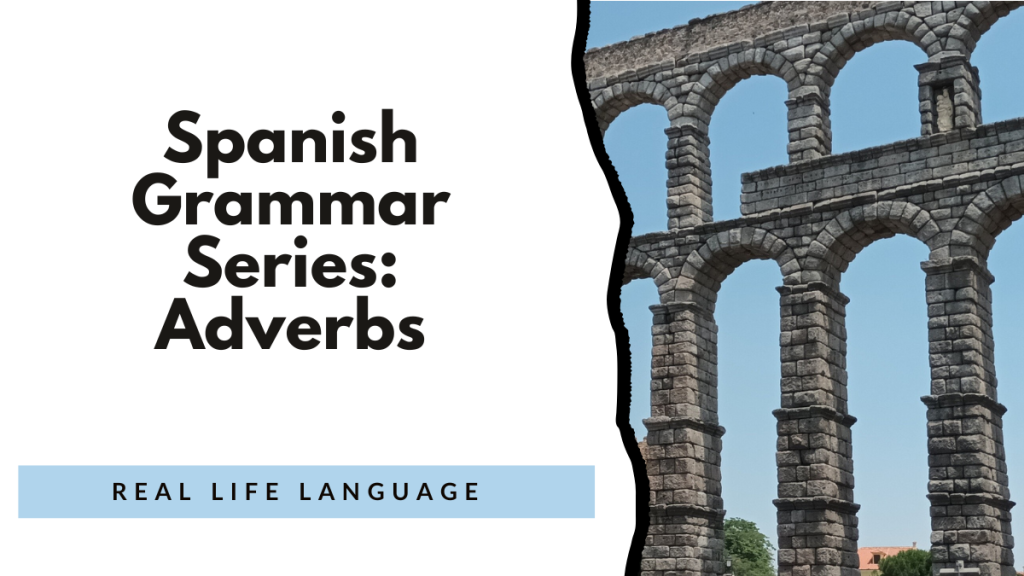Participles as Adjectives in Spanish
(Los Participios como Adjetivos)
In Spanish, the past participle (participio pasado) can be used not only to form compound tenses, but also to function as an adjective. When used this way, the participle describes a condition, result, or characteristic of a noun.
Just like regular adjectives, participles must agree in gender and number with the nouns they modify. This allows speakers to express states such as “the door is closed,” “the homework is finished,” or “the windows are broken” with accuracy and detail. Understanding participles as adjectives helps students describe situations clearly and naturally in Spanish.
1) Review: What Is a Past Participle?
The past participle is a verb form that expresses a completed action or a resulting state.
When used as an adjective, it describes how someone or something is as the result of an action.
| Verb | Meaning | Participle | English |
| cerrar | to close | cerrado | closed |
| romper | to break | roto | broken |
| abrir | to open | abierto | open |
| hacer | to do | hecho | done |
| escribir | to write | escrito | written |
Examples:
- La puerta está cerrada. → The door is closed.
- Los platos están lavados. → The dishes are washed.
- El trabajo está hecho. → The work is done.
2) Agreement Rules
When used as adjectives, participles must agree in gender and number with the nouns they modify.
| Gender / Number | Ending | Example | Translation |
| Masculine singular | -o | el libro cerrado | the closed book |
| Feminine singular | -a | la puerta cerrada | the closed door |
| Masculine plural | -os | los libros cerrados | the closed books |
| Feminine plural | -as | las puertas cerradas | the closed doors |
Examples:
- El documento está escrito. → The document is written.
- La carta está escrita. → The letter is written.
- Los documentos están escritos. → The documents are written.
- Las cartas están escritas. → The letters are written.
3) Difference Between Participles with “Haber” vs. as Adjectives
| Use | Auxiliary | Agreement | Example | Translation |
| With haber (compound tense) | haber | No agreement | He escrito una carta. | I have written a letter. |
| As adjective | none or with estar/ser | Agreement | La carta está escrita. | The letter is written. |
Rule:
- With haber, the participle stays in masculine singular form (no agreement).
- As an adjective (alone or with estar/ser), it changes form to match the noun.
Examples:
- Han roto la ventana. → They have broken the window.
- La ventana está rota. → The window is broken.
4) Common Participles Used as Adjectives
| Infinitive | Participle | Meaning (Adjectival Use) | Example |
| abrir | abierto | open | La tienda está abierta. |
| cerrar | cerrado | closed | Las puertas están cerradas. |
| romper | roto | broken | El vaso está roto. |
| hacer | hecho | done, made | El trabajo está hecho. |
| poner | puesto | placed, positioned | El cuadro está puesto en la pared. |
| escribir | escrito | written | La carta está escrita. |
| decir | dicho | said | Las palabras dichas por el maestro… |
| morir | muerto | dead | El pez está muerto. |
| cubrir | cubierto | covered | La mesa está cubierta. |
| resolver | resuelto | solved | El problema está resuelto. |
| ver | visto | seen | Las películas vistas fueron interesantes. |
| freír | frito | fried | Los huevos fritos están deliciosos. |
5) Using “Estar” with Participles (Condition or Result)
When used with estar, the participle expresses a temporary state or condition — the result of an action.
Examples:
- La ventana está rota. → The window is broken.
- El café está preparado. → The coffee is prepared.
- Los niños están dormidos. → The children are asleep.
- La mesa está puesta. → The table is set.
Rule: Estar + participle emphasizes state rather than the action itself.
6) Using “Ser” with Participles (Passive Voice)
When used with ser, the participle expresses the passive voice — showing who or what performed the action.
Formula:
ser + participle + por + agent
| Example | Translation |
| El libro fue escrito por García Márquez. | The book was written by García Márquez. |
| La canción fue compuesta por Shakira. | The song was composed by Shakira. |
| Los cuadros fueron pintados por Picasso. | The paintings were painted by Picasso. |
With ser, the participle must agree with the noun in gender and number, just like with estar.
7) Using Participles Alone as Adjectives
Participles can function as stand-alone adjectives without ser or estar.
Examples:
- los niños dormidos → the sleeping children
- una persona cansada → a tired person
- una puerta cerrada → a closed door
- una ciudad destruida → a destroyed city
- una mujer sorprendida → a surprised woman
Here, the participle describes the noun’s state or characteristic, not an action.
8) Participles vs. Adjectives from Verbs
Some participles have developed into permanent adjectives — they describe personality or state even if no action is implied.
| Verb | Participle (Adjectival) | Meaning |
| cansar | cansado | tired |
| preocupar | preocupado | worried |
| aburrir | aburrido | bored / boring |
| interesar | interesado | interested |
| sorprender | sorprendido | surprised |
| confundir | confundido | confused |
| vestir | vestido | dressed |
| casar | casado | married |
Examples:
- Estoy cansado. → I’m tired.
- Ella está casada. → She’s married.
- Los estudiantes están aburridos. → The students are bored.
9) Practice: Fill in the Blanks
Choose the correct participle and form it to agree in gender and number.
- Las ventanas están __________ (cerrar).
- Los niños están __________ (cansar).
- El libro fue __________ (escribir) por Cervantes.
- Las tareas están __________ (hacer).
- La casa está __________ (limpiar).
Answers:
- cerradas
- cansados
- escrito
- hechas
- limpia
10) Practice: Translate
- The door is open.
- The dishes are washed.
- The problem is solved.
- The students are tired.
- The letters were written by my grandmother.
Answers:
- La puerta está abierta.
- Los platos están lavados.
- El problema está resuelto.
- Los estudiantes están cansados.
- Las cartas fueron escritas por mi abuela.
11) Common Pitfalls & Fixes
| Wrong | Correct | Why |
| Las puertas están cerrar. | Las puertas están cerradas. | Must use participle as adjective. |
| He abiertas las ventanas. | He abierto las ventanas. | With haber, no agreement. |
| Los platos están lavados. | Correct! | Agreement in gender and number. |
| La comida fue preparar. | La comida fue preparada. | Passive voice requires participle. |
| Las ventanas están abridos. | Las ventanas están abiertas. | Irregular participle form. |
12) Quick Reference Chart
| Function | Formula | Agreement | Example | Meaning |
| As adjective | participle alone | Yes | puerta cerrada | closed door |
| With estar | estar + participle | Yes | está abierta | is open (state) |
| With ser | ser + participle | Yes | fue escrita por… | was written by… |
| With haber | haber + participle | No | he abierto | I have opened |
Why Participles as Adjectives Matter
Using participles as adjectives helps learners:
- Describe conditions and results naturally (la puerta está abierta)
- Form passive voice correctly (fue escrita por…)
- Build rich, descriptive language (niños dormidos, personas cansadas)
- Understand how verb forms connect to adjectives, deepening grammatical awareness
They’re a bridge between verb and adjective, adding fluency, precision, and variety to Spanish communication.
Building Proficiency for World Language Learners: 100+ High-Interest Activities
Discover over 100 dynamic activities to make world language learning interactive and fun. I wrote this book with some of my favorite activities for educators aiming to build proficiency with high-impact strategies.
Learn more and get your copy here.
5 Weeks of No and Low Prep Fun
Need quick, engaging activities for your class? This free guide includes 25 no-prep and low-prep ideas to save time while keeping students excited about learning.
Download your free copy now.
100s of videos to learn Spanish:

